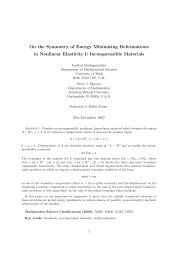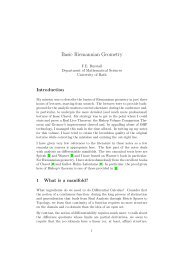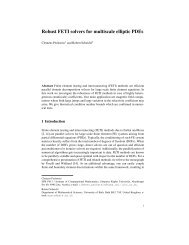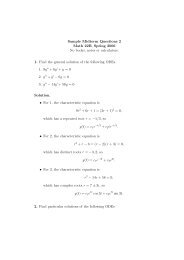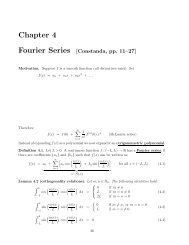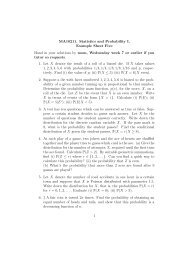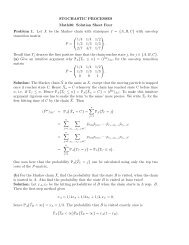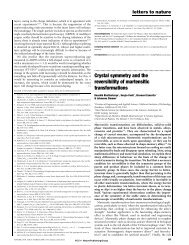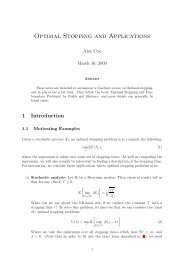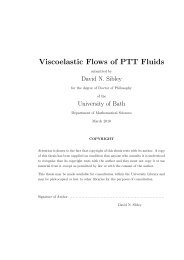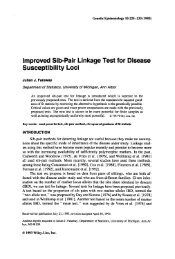1 Lévy Processes and Infinite Divisibility - Department of ...
1 Lévy Processes and Infinite Divisibility - Department of ...
1 Lévy Processes and Infinite Divisibility - Department of ...
You also want an ePaper? Increase the reach of your titles
YUMPU automatically turns print PDFs into web optimized ePapers that Google loves.
AccordingtoTheorem1.2thereexistsa<strong>Lévy</strong>processwhose<strong>Lévy</strong>–Khintchineformula is given by Ψ, the so-called gamma process.Suppose now that X = {X t : t ≥ 0} is a gamma process. Stationaryindependent increments tell us that for all 0 ≤ s < t < ∞, X t = X s + ˜X t−swhere ˜X t−s is an independent copy <strong>of</strong> X t−s . The fact that the latter is strictlypositive with probabilityone (on account <strong>of</strong>it being gamma distributed) impliesthat X t > X s almost surely. Hence a gamma process is an example <strong>of</strong> a <strong>Lévy</strong>process with almost surely non-decreasing paths (in fact its paths are strictlyincreasing). Another example <strong>of</strong> a <strong>Lévy</strong> process with non-decreasing paths isa compound Poisson process where the jump distribution F is concentrated on(0,∞). Note however that a gamma process is not a compound Poisson processon two counts. Firstly, its <strong>Lévy</strong> measure has infinite total mass unlike the <strong>Lévy</strong>measure <strong>of</strong> a compound Poisson process, which is necessarily finite (<strong>and</strong> equalto the arrival rate <strong>of</strong> jumps). Secondly, whilst a compound Poisson process withpositive jumps does have paths, which are almost surely non-decreasing, it doesnot have paths that are almost surely strictly increasing.<strong>Lévy</strong> processes whose paths are almost surely non-decreasing (or simplynon-decreasing for short) are called subordinators.2.5 Inverse Gaussian <strong>Processes</strong>Suppose as usual that B = {B t : t ≥ 0} is a st<strong>and</strong>ard Brownian motion. Definethe first passage timeτ s = inf{t > 0 : B t +bt > s}, (2.2)that is, the first time a Brownian motion with linear drift b > 0 crosses abovelevel s. Recall that τ s is a stopping time 3 . Moreover,since Brownianmotion hascontinuous paths we know that B τs +bτ s = s almost surely. From the StrongMarkov Property it is known that {B τs+t+b(τ s +t)−s : t ≥ 0} is equal in lawto B <strong>and</strong> hence for all 0 ≤ s < t,τ t = τ s +˜τ t−s ,where ˜τ t−s is an independent copy <strong>of</strong> τ t−s . This shows that the process τ :={τ t : t ≥ 0} has stationary independent increments. Continuity <strong>of</strong> the paths <strong>of</strong>{B t +bt : t ≥ 0} ensures that τ has right continuous paths. Further, it is clearthat τ has almost surely non-decreasing paths, which guarantees its paths haveleft limits as well as being yet another example <strong>of</strong> a subordinator. According toits definition as a sequence <strong>of</strong> first passage times, τ is also the almost sure rightinverse <strong>of</strong> the path <strong>of</strong> the graph <strong>of</strong> {B t +bt : t ≥ 0} in the sense <strong>of</strong> (2.2). Fromthis τ earns its name as the inverse Gaussian process.3 We assume that the reader is familiar with the notion <strong>of</strong> a stopping time for a Markovprocess. By definition, the r<strong>and</strong>om time τ is a stopping time with respect to the filtration{G t : t ≥ 0} if for all t ≥ 0,{τ ≤ t} ∈ G t.9



